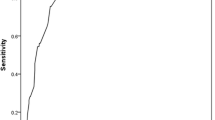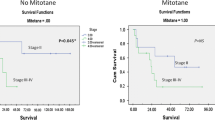Abstract
Objective
To evaluate the relevance of tumour size in adrenal tumours in the estimation of malignancy risk and in the outcomes of adrenalectomy.
Methods
We evaluate the histological results and surgical outcomes (intraoperative and postsurgical complications) in a retrospective single-centre cohort of patients without history of active extraadrenal malignancy with adrenal tumours consecutively operated in our centre during January 2010 and December 2020. We compared these results in lesions smaller and larger than 40, 50, and 60 mm.
Results
Of 131 patients with adrenal tumours who underwent adrenalectomy, 76 (58.0%) had adrenal masses measuring ≥ 40 mm; 47 were > 50 mm and 28 > 60 mm. The final diagnosis was adrenocortical carcinoma (ACC) in 7 patients, pheochromocytoma in 35, and benign lesions in the remaining. All patients with ACC had adrenal masses > 50 mm, with Hounsfield units > 40 and low lipidic content in the CT. The risk of ACC and pheochromocytoma increased as tumour size did. The diagnostic accuracy of tumour size was quite good for the prediction of ACC (AUC-ROC 0.883). Nevertheless, when only adrenal tumours with HU < 40 were considered, the risk of ACC was 0% independent of tumour size. For pheochromocytomas, the risk was of 8.6% independent of tumour size for lesions with < 20HU. The risk of intraoperative and postoperative complications was independent of tumour size.
Conclusion
Risk of malignancy and of pheochromocytoma increased as tumour size increased, but, in the presurgical estimation of malignancy risk and of pheochromocytoma, not only tumour size, also lipidic content and other radiological features, should be considered. The risk of complications was independent of tumour size, but hospital stay was longer in patients with complication or open approach.

Similar content being viewed by others
References
Araujo-Castro M, Iturregui Guevara M, Calatayud Gutiérrez M, Parra Ramírez P, Gracia Gimeno P, Hanzu FA et al (2020) Practical guide on the initial evaluation, follow-up, and treatment of adrenal incidentalomas Adrenal Diseases Group of the Spanish Society of Endocrinology and Nutrition. Endocrinol Diabetes y Nutr 67:408–419. https://doi.org/10.1016/j.endinu.2020.03.002
Fassnacht M, Arlt W, Bancos I, Dralle H, Newell-Price J, Sahdev A et al (2016) Management of adrenal incidentalomas: European Society of Endocrinology Clinical Practice Guideline in collaboration with the European Network for the Study of Adrenal Tumors. Eur J Endocrinol 175:G1-34. https://doi.org/10.1530/EJE-16-0467
Mantero F, Terzolo M, Arnaldi G, Osella G, Masini AM, Alı̀ A et al (2000) A survey on adrenal incidentaloma in Italy 1. J Clin Endocrinol Metab 85:637–644. https://doi.org/10.1210/jcem.85.2.6372
Frilling A, Tecklenborg K, Weber F, Kühl H, Müller S, Stamatis G et al (2004) Importance of adrenal incidentaloma in patients with a history of malignancy. Surgery 136:1289–1296. https://doi.org/10.1016/j.surg.2004.06.060
Cawood TJ, Hunt PJ, O’Shea D, Cole D, Soule S (2009) Recommended evaluation of adrenal incidentalomas is costly, has high false-positive rates and confers a risk of fatal cancer that is similar to the risk of the adrenal lesion becoming malignant; time for a rethink? Eur J Endocrinol 161:513–527. https://doi.org/10.1530/EJE-09-0234
Cicek MC, Gunseren KO, Senol K, Vuruskan H, Yavascaoglu I (2021) Is 6 cm diameter an upper limit for adrenal tumors to perform laparoscopic adrenalectomy? J Laparoendosc Adv Surg Tech A 31:301–305. https://doi.org/10.1089/LAP.2020.0505
Field N, Cohen T, Struelens MJ, Palm D, Cookson B, Glynn JR et al (2014) Strengthening the Reporting of Molecular Epidemiology for Infectious Diseases (STROME-ID): an extension of the STROBE statement. Lancet Infect Dis 14:341–352. https://doi.org/10.1016/S1473-3099(13)70324-4
Nieman LK, Biller BMKK, Findling JW, Newell-Price J, Savage MO, Stewart PM et al (2008) The diagnosis of Cushing’s syndrome: an endocrine society clinical practice guideline. J Clin Endocrinol Metab 93:1526–1540. https://doi.org/10.1210/jc.2008-0125
Funder JW, Carey RM, Mantero F, Murad MH, Reincke M, Shibata H et al (2016) The management of primary aldosteronism: case detection, diagnosis, and treatment: an endocrine society clinical practice guideline. J Clin Endocrinol Metab 101:1889–1916. https://doi.org/10.1210/jc.2015-4061
Lenders JWM, Duh QY, Eisenhofer G, Gimenez-Roqueplo AP, Grebe SKG, Murad MH et al (2014) Pheochromocytoma and paraganglioma: an endocrine society clinical practice guideline. J Clin Endocrinol Metab 99:1915–1942. https://doi.org/10.1210/jc.2014-1498
Araujo-Castro M, Sampedro Núñez MA, Marazuela M (2019) Autonomous cortisol secretion in adrenal incidentalomas. Endocrine. https://doi.org/10.1007/s12020-019-01888-y
Israel GM, Korobkin M, Wang C, Hecht EN, Krinsky GA (2004) Comparison of unenhanced CT and chemical shift MRI in evaluating lipid-rich adrenal adenomas. Am J Roentgenol 183:215–219. https://doi.org/10.2214/ajr.183.1.1830215
Dindo D, Demartines N, Clavien PA (2004) Classification of surgical complications: a new proposal with evaluation in a cohort of 6336 patients and results of a survey. Ann Surg 240:205–213. https://doi.org/10.1097/01.SLA.0000133083.54934.AE
Araujo-Castro M, Centeno RG, López-García MC, Lamas C, Álvarez-Escolá C, Gutiérrez MC et al (2021) Risk factors for intraoperative complications in pheochromocytomas. Endocr Relat Cancer 28:695–703. https://doi.org/10.1530/ERC-21-0230
Araujo-Castro M, García Centero R, López-García MC, Álvarez Escolá C, Calatayud Gutiérrez M, Blanco Carrera C et al (2021) Surgical outcomes in the pheochromocytoma surgery. Results from the PHEO-RISK STUDY. Endocrine 74:676–684. https://doi.org/10.1007/s12020-021-02843-6
Weiss LM (1984) Comparative histologic study of 43 metastasizing and nonmetastasizing adrenocortical tumors. Am J Surg Pathol 8:163–169. https://doi.org/10.1097/00000478-198403000-00001
Bisceglia M, Ludovico O, Di Mattia A, Ben-Dor D, Sandbank J, Pasquinelli G et al (2004) Adrenocortical oncocytic tumors: report of 10 cases and review of the literature. Int J Surg Pathol 12:231–243. https://doi.org/10.1177/106689690401200304
Kebebew E (2021) Adrenal incidentaloma. N Engl J Med 384:1542–1551. https://doi.org/10.1056/NEJMCP2031112
Wang TS, Cheung K, Roman SA, Sosa JA (2012) A cost-effectiveness analysis of adrenalectomy for nonfunctional adrenal incidentalomas: is there a size threshold for resection? Surgery 152:1125–1132. https://doi.org/10.1016/J.SURG.2012.08.011
Cambos S, Tabarin A (2020) Management of adrenal incidentalomas: working through uncertainty. Best Pract Res Clin Endocrinol Metab. https://doi.org/10.1016/J.BEEM.2020.101427
Reginelli A, Vacca G, Belfiore M, Sangiovanni A, Nardone V, Grassi R et al (2020) Pitfalls and differential diagnosis on adrenal lesions: current concepts in Ct/Mr imaging: a narrative review. Gland Surg 9:2331–2342. https://doi.org/10.21037/GS-20-559
De Leo A, Mosconi C, Zavatta G, Tucci L, Nanni C, Selva S et al (2020) Radiologically defined lipid-poor adrenal adenomas: histopathological characteristics. J Endocrinol Invest 43:1197–1204. https://doi.org/10.1007/S40618-020-01198-5
Crimì F, Quaia E, Cabrelle G, Zanon C, Pepe A, Regazzo D et al (2022) Diagnostic accuracy of CT texture analysis in adrenal masses: a systematic review. Int J Mol Sci. https://doi.org/10.3390/IJMS23020637
Vanbrabant T, Fassnacht M, Assie G, Dekkers OM (2018) Influence of hormonal functional status on survival in adrenocortical carcinoma: systematic review and meta-analysis. Eur J Endocrinol 179:429–436. https://doi.org/10.1530/EJE-18-0450
Chen Y, Scholten A, Chomsky-Higgins K, Nwaogu I, Gosnell JE, Seib C, et al. Risk factors associated with perioperative complications and prolonged length of stay after laparoscopic adrenalectomy. JAMA Surg. 2018;153(11):1036–41
Araujo-Castro M, García Centeno R, Robles Lázaro C, Parra Ramírez P, Gracia Gimeno P, Martín Rojas-Marcos P, et al. Predictive model of pheochromocytoma based on the imaging features of the adrenal tumours. Sci Rep. 2022;12(1):2671. https://doi.org/10.1038/s41598-022-06655-0
Chambre C, McMurray E, Baudry C, Lataud M, Guignat L, Gaujoux S et al (2015) The 10 Hounsfield units unenhanced computed tomography attenuation threshold does not apply to cortisol secreting adrenocortical adenomas. Eur J Endocrinol 173:325–332. https://doi.org/10.1530/EJE-15-0036
Prakobpon T, Santi-ngamkun A, Usawachintachit M, Ratchanon S, Sowanthip D, Panumatrassamee K (2021) Laparoscopic transperitoneal adrenalectomy in the large adrenal tumor from single center experience. BMC Surg. https://doi.org/10.1186/S12893-021-01080-Y
Balla A, Corallino D, Ortenzi M, Palmieri L, Meoli F, Guerrieri M et al (2022) Cancer risk in adrenalectomy: are adrenal lesions equal or more than 4 cm a contraindication for laparoscopy? Surg Endosc 36:1131–1142. https://doi.org/10.1007/S00464-021-08380-7
Zhu W, Wang S, Du G, Liu H, Lu J, Yang W (2019) Comparison of retroperitoneal laparoscopic versus open adrenalectomy for large pheochromocytoma: a single-center retrospective study. World J Surg Oncol. https://doi.org/10.1186/s12957-019-1649-x
Daza J, Beksac AT, Kannappan M, Chong J, Abaza R, Hemal A et al (2021) Identifying tumor-related risk factors for simultaneous adrenalectomy in patients with cT1-cT2 kidney cancer during robotic assisted laparoscopic radical nephrectomy. Minerva Urol Nephrol. 73:72–77. https://doi.org/10.23736/S0393-2249.19.03440-4
Wang J, Wang Z, Zhu Y, Yu K, Li X, Liu C et al (2020) Minimally invasive adrenalectomy results in equivalent perioperative outcomes versus open adrenalectomy for adrenal mass larger than 6 cm: a retrospective propensity score-matched study. Eur J Surg Oncol 46:839–846. https://doi.org/10.1016/J.EJSO.2020.01.031
Buxton J, Vun SH, van Dellen D, Wadsworth R, Augustine T (2019) Laparoscopic hand-assisted adrenalectomy for tumours larger than 5 cm. Clin Endocrinol (Oxf) 90:74–78. https://doi.org/10.1111/CEN.13883
Ceccato F, Barbot M, Scaroni C, Boscaro M (2021) Frequently asked questions and answers (if any) in patients with adrenal incidentaloma. J Endocrinol Invest 44:2749–2763. https://doi.org/10.1007/S40618-021-01615-3
Funding
SENDIMAD: BECA SENDIMAD de Ayuda a la Investigación en Endocrinología, Nutrición y Diabetes 2019. IRYCIS: Convocatoria intramural de ayudas a proyectos de investigación de investigadores noveles, investigadores clínicos asociados y/o grupos emergentes del Hospital Universitario Ramón y Cajal 2019.
Author information
Authors and Affiliations
Corresponding author
Ethics declarations
Conflict of interest
The authors have no conflict of interest.
Ethical approval
All procedures performed in the participants of the study were in accordance with the ethical standards of the institutional research committee and with the 1964 Helsinki Declaration and its later amendments or comparable ethical standards.
Informed consent
Patient consent was waived due to the retrospective nature of the study. Only for patients who continued follow-up or prospectively included the informed consent was requested.
Additional information
Publisher's Note
Springer Nature remains neutral with regard to jurisdictional claims in published maps and institutional affiliations.
Rights and permissions
About this article
Cite this article
Mínguez Ojeda, C., Gómez Dos Santos, V., Álvaro Lorca, J. et al. Tumour size in adrenal tumours: its importance in the indication of adrenalectomy and in surgical outcomes—a single-centre experience. J Endocrinol Invest 45, 1999–2006 (2022). https://doi.org/10.1007/s40618-022-01836-0
Received:
Accepted:
Published:
Issue Date:
DOI: https://doi.org/10.1007/s40618-022-01836-0




